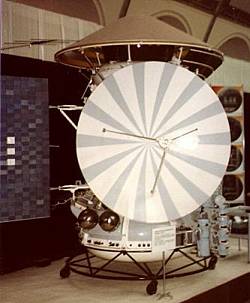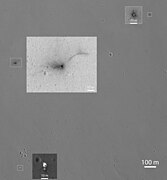
Viking 1 was the first of two spacecraft, along with Viking 2, each consisting of an orbiter and a lander, sent to Mars as part of NASA's Viking program. The lander touched down on Mars on July 20, 1976, the first successful Mars lander in history. Viking 1 operated on Mars for 2,307 days or 2245 Martian solar days, the longest Mars surface mission until the record was broken by the Opportunity rover on May 19, 2010.

Mars 6, also known as 3MP No.50P was a Soviet spacecraft launched to explore Mars. A 3MP bus spacecraft launched as part of the Mars program, it consisted of a lander, and a coast stage with instruments to study Mars as it flew past.

The Mars 2 was an uncrewed space probe of the Mars program, a series of uncrewed Mars landers and orbiters launched by the Soviet Union beginning 19 May 1971. The Mars 2 and Mars 3 missions consisted of identical spacecraft, each with an orbiter and an attached lander. The orbiter is identical to the Venera 9 bus. The type of bus/orbiter is the 4MV. They were launched by a Proton-K heavy launch vehicle with a Blok D upper stage. The lander of Mars 2 became the first human-made object to reach the surface of Mars, although the landing system failed and the lander was lost.

Mars 3 was a robotic space probe of the Soviet Mars program, launched May 28, 1971, nine days after its twin spacecraft Mars 2. The probes were identical robotic spacecraft launched by Proton-K rockets with a Blok D upper stage, each consisting of an orbiter and an attached lander. After the Mars 2 lander crashed on the Martian surface, the Mars 3 lander became the first spacecraft to attain a soft landing on Mars, on December 2, 1971. It failed 110 seconds after landing, having transmitted only a gray image with no details. The Mars 2 orbiter and Mars 3 orbiter continued to circle Mars and transmit images back to Earth for another eight months.

Mars Pathfinder is an American robotic spacecraft that landed a base station with a roving probe on Mars in 1997. It consisted of a lander, renamed the Carl Sagan Memorial Station, and a lightweight, 10.6 kg (23 lb) wheeled robotic Mars rover named Sojourner, the first rover to operate outside the Earth–Moon system.

A lander is a spacecraft that descends towards, then comes to rest on the surface of an astronomical body other than Earth. In contrast to an impact probe, which makes a hard landing that damages or destroys the probe upon reaching the surface, a lander makes a soft landing after which the probe remains functional.

A Mars rover is a remote-controlled motor vehicle designed to travel on the surface of Mars. Rovers have several advantages over stationary landers: they examine more territory, they can be directed to interesting features, they can place themselves in sunny positions to weather winter months, and they can advance the knowledge of how to perform very remote robotic vehicle control. They serve a different purpose than orbital spacecraft like Mars Reconnaissance Orbiter. A more recent development is the Mars helicopter.

The planet Mars has been explored remotely by spacecraft. Probes sent from Earth, beginning in the late 20th century, have yielded a large increase in knowledge about the Martian system, focused primarily on understanding its geology and habitability potential. Engineering interplanetary journeys is complicated and the exploration of Mars has experienced a high failure rate, especially the early attempts. Roughly sixty percent of all spacecraft destined for Mars failed before completing their missions, with some failing before their observations could even begin. Some missions have been met with unexpected success, such as the twin Mars Exploration Rovers, Spirit and Opportunity, which operated for years beyond their specification.

A Mars landing is a landing of a spacecraft on the surface of Mars. Of multiple attempted Mars landings by robotic, uncrewed spacecraft, ten have had successful soft landings. There have also been studies for a possible human mission to Mars including a landing, but none have been attempted. Soviet Union’s Mars 3, which landed in 1971, was the first successful Mars landing. As of 2023, the Soviet Union, United States and China have conducted Mars landings successfully.

Mars atmospheric entry is the entry into the atmosphere of Mars. High velocity entry into Martian air creates a CO2-N2 plasma, as opposed to O2-N2 for Earth air. Mars entry is affected by the radiative effects of hot CO2 gas and Martian dust suspended in the air. Flight regimes for entry, descent, and landing systems include aerocapture, hypersonic, supersonic, and subsonic.

Bradbury Landing is the August 6, 2012, landing site within Gale crater on planet Mars of the Mars Science Laboratory (MSL) Curiosity rover. On August 22, 2012, on what would have been his 92nd birthday, NASA named the site for author Ray Bradbury, who had died on June 5, 2012. The coordinates of the landing site on Mars are: 4.5895°S 137.4417°E.

Mars 2020 is a NASA mission that includes the rover Perseverance, the now-retired small robotic helicopter Ingenuity, and associated delivery systems, as part of the Mars Exploration Program. Mars 2020 was launched on an Atlas V rocket at 11:50:01 UTC on July 30, 2020, and landed in the Martian crater Jezero on February 18, 2021, with confirmation received at 20:55 UTC. On March 5, 2021, NASA named the landing site Octavia E. Butler Landing. As of 23 March 2024, Perseverance has been on Mars for 1099 sols. Ingenuity operated on Mars for 1042 sols before sustaining serious damage to its rotor blades, possibly all four, causing NASA to retire the craft on January 25, 2024.

Schiaparelli EDM was a failed Entry, Descent, and Landing Demonstrator Module (EDM) of the ExoMars programme—a joint mission of the European Space Agency (ESA) and the Russian Space Agency Roscosmos. It was built in Italy and was intended to test technology for future soft landings on the surface of Mars. It also had a limited but focused science payload that would have measured atmospheric electricity on Mars and local meteorological conditions.
The following outline is provided as an overview of and topical guide to Mars:

The Mars 2020 mission, consisting of the rover Perseverance and helicopter Ingenuity, was launched on July 30, 2020, and landed in Jezero crater on Mars on February 18, 2021. As of March 21, 2024, Perseverance has been on the planet for 1097 sols. Ingenuity operated for 1042 sols until its rotor blades, possibly all four, were damaged during the landing of flight 72 on January 18, 2024, causing NASA to retire the craft.

Octavia E. Butler Landing is the February 18, 2021, landing site of the Mars 2020 Perseverance rover within Jezero crater on planet Mars. On March 5, 2021, NASA named the site for the renowned American science fiction author, Octavia E. Butler, who died on February 24, 2006. The Mars landing took place nearly 15 years to the day after her death. The coordinates of the landing site on Mars are 18.44°N 77.45°E





































